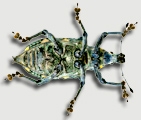Church SH, Donoughe S, de Medeiros BAS, Extavour CG.
A dataset of egg size and shape from more than 6,700 insect species. Sci Data. 2019;6 :104.
DOI (Full text)AbstractOffspring size is a fundamental trait in disparate biological fields of study. This trait can be measured as the size of plant seeds, animal eggs, or live young, and it influences ecological interactions, organism fitness, maternal investment, and embryonic development. Although multiple evolutionary processes have been predicted to drive the evolution of offspring size, the phylogenetic distribution of this trait remains poorly understood, due to the difficulty of reliably collecting and comparing offspring size data from many species. Here we present a dataset of 10,449 morphological descriptions of insect eggs, with records for 6,706 unique insect species and representatives from every extant hexapod order. The dataset includes eggs whose volumes span more than eight orders of magnitude. We created this dataset by partially automating the extraction of egg traits from the primary literature. In the process, we overcame challenges associated with large-scale phenotyping by designing and employing custom bioinformatic solutions to common problems. We matched the taxa in this dataset to the currently accepted scientific names in taxonomic and genetic databases, which will facilitate the use of these data for testing pressing evolutionary hypotheses in offspring size evolution.
Church SH, Donoughe S, de Medeiros BAS, Extavour CG.
Insect egg size and shape evolve with ecology but not developmental rate. Nature. 2019;571 :58-62.
DOI (full text)AbstractOver the course of evolution, organism size has diversified markedly. Changes in size are thought to have occurred because of developmental, morphological and/or ecological pressures. To perform phylogenetic tests of the potential effects of these pressures, here we generated a dataset of more than ten thousand descriptions of insect eggs, and combined these with genetic and life-history datasets. We show that, across eight orders of magnitude of variation in egg volume, the relationship between size and shape itself evolves, such that previously predicted global patterns of scaling do not adequately explain the diversity in egg shapes. We show that egg size is not correlated with developmental rate and that, for many insects, egg size is not correlated with adult body size. Instead, we find that the evolution of parasitoidism and aquatic oviposition help to explain the diversification in the size and shape of insect eggs. Our study suggests that where eggs are laid, rather than universal allometric constants, underlies the evolution of insect egg size and shape.
